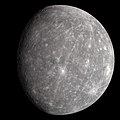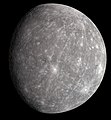Datei:Mercury in true color.jpg

Gress dea Voaschau: 600 × 600 Pixel Weitere Auflésungan: 240 × 240 Pixel | 480 × 480 Pixel | 768 × 768 Pixel | 1.040 × 1.040 Pixel.
Version in hechara Auflesung (1.040 × 1.040 Pixel, Dateigress: 408 KB, MIME-Typ: image/jpeg)
Dateiversiona
Wensd auf an Zeitpunkt klickst, nacha konst a friaane Version lodn.
| Version vom | Vorschaubuidl | Dimensióna | Nutzer | Kommentar | |
|---|---|---|---|---|---|
| aktuell | 10:16, 15. Mai 2023 |  | 1.040 × 1.040 (408 KB) | CactiStaccingCrane | Reverted to version as of 10:42, 24 July 2022 (UTC) |
| 10:01, 15. Mai 2023 |  | 1.024 × 1.024 (837 KB) | CactiStaccingCrane | Manually merge the original monochrome image with the calibrated color image to eek out more resolution | |
| 12:42, 24. Jul. 2022 |  | 1.040 × 1.040 (408 KB) | JCP-JohnCarlo | Make this planet image center | |
| 12:25, 24. Jul. 2022 |  | 1.040 × 1.040 (710 KB) | JCP-JohnCarlo | Canvas image | |
| 11:00, 3. Nóv. 2019 |  | 960 × 1.040 (865 KB) | Mirecki | User created page with UploadWizard |
Dateivawendung
Seitn wo de Datei nutzn:
Globale Dateinutzung
D'noochéfóiganden åndern Wikis vawénden dé Datei:
- Vawendung af af.wikipedia.org
- Vawendung af als.wikipedia.org
- Vawendung af ar.wikibooks.org
- Vawendung af as.wikipedia.org
- Vawendung af be-tarask.wikipedia.org
- Vawendung af beta.wikiversity.org
- Vawendung af bn.wikibooks.org
- Vawendung af bo.wikipedia.org
- Vawendung af br.wikipedia.org
- Vawendung af ceb.wikipedia.org
- Vawendung af ckb.wiktionary.org
- Vawendung af csb.wikipedia.org
- Vawendung af cv.wikipedia.org
- Vawendung af cy.wikipedia.org
- Vawendung af de.wikipedia.org
- Vawendung af dty.wikipedia.org
- Vawendung af dz.wikipedia.org
- Vawendung af eml.wikipedia.org
- Vawendung af en.wikipedia.org
- Mercury (planet)
- Terrestrial planet
- The Planets
- Timeline of discovery of Solar System planets and their moons
- List of Solar System objects by size
- List of gravitationally rounded objects of the Solar System
- User:Kwamikagami/sandbox
- NASA
- User:Kazkaskazkasako/Books/Physical sciences
- Talk:Mercury (planet)/Archive 3
- User:Nrco0e/Userboxes
- User:Applekle/sandbox
- Wikipedia:Userboxes/Location/Extraterrestrial
- Talk:The Planets/GA1
- User:Double sharp/Largest Solar System objects
- User:TomMasterReal
- User:Nrco0e/Userboxes/FavMercury
- User:KeroseneLover100/sandbox/sandbox
- Vawendung af en.wikibooks.org
- Vawendung af en.wiktionary.org
- Vawendung af eo.wikipedia.org
- Vawendung af es.wikipedia.org
Weitere globale Verwendungen dieser Datei anschauen.

